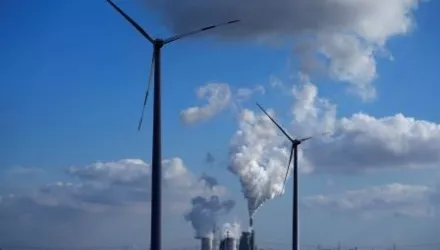The full discussion paper is available for download here: http://belfercenter.ksg.harvard.edu/publication/18678/
OVERVIEW
Both the nature of international climate policy architectures and the development and diffusion of new energy technologies could dramatically influence future costs of reducing global emissions of greenhouse gases. This paper explores the implications of interactions between technology availability and performance and international policy architectures for technology choice and the social cost of limiting atmospheric CO2 concentrations to 500 ppm by the year 2095. Key issues explored in the paper include the role of bioenergy production with CO2 capture and storage (CCS), overshoot concentration pathways, and the sensitivity of mitigation costs to policy and technology.
DISCUSSION
Technology and policy are both important to limiting anthropogenic climate change. The development of cheaper and more effective technologies will be critical for reducing the costs and increasing the social and political viability of substantial greenhouse gas emissions reductions. This paper analyzes the relationship between policy architecture and technological development. It simulates the global costs of a variety of policy and technology scenarios, using the MiniCAM integrated assessment model. MiniCAM combines a technologically-detailed global energy-economy-agricultural land use model with a set of atmospheric, climate, and ice-melt models. Four technology development scenarios are explored: (1) a reference scenario under which technological improvement is modest and neither nuclear power nor CCS are allowed to deploy, (2) a scenario under which only bioenergy, CCS, and hydrogen technologies all improve rapidly, (3) a scenario under which only renewable, nuclear, and energy efficiency technologies all improve rapidly, and (4) an "advanced" technology scenario under which all of the above technologies improve rapidly.
The analysis combines these technology scenarios with two alternative international policy architectures: one with full participation by all nations from 2012 onward and another with delayed and incomplete participation by developing nations. Both architectures are designed to limit the concentration of atmospheric CO2 to 500 ppm in the year 2095. By construction the first is more economically efficient, but unlikely to be realized. The second is less efficient and shifts emissions mitigation toward presently developed regions and away from developing regions.
Simulation results show that it is feasible to limit atmospheric CO2 concentrations to 500 ppm in 2095 under the reference technology scenario. However, the economic cost is dramatically higher than in any of the scenarios in which technological improvements occur. Carbon prices in the reference scenario are between two and six times greater than in the advanced technology scenario in almost every year between 2012 and 2095.
KEY FINDINGS & RECOMMENDATIONS
- Technology is even more important to reducing the costs of emissions mitigation when international policy structures deviatefrom immediate and full participation. In simulations, the global cost savings from advanced technology are twice as large
when participation in the international agreement is incomplete. - International diffusion of climate technology may be as or more important to domestic mitigation cost containment as domestictechnology diffusion. The vast majority of technology research is conducted at the national level. However, development and diffusion of climate change technology is a global public good, since it reduces future global emissions. This implies that key findings & recommendations there is a strong, albeit indirect, incentive for individual nations to implement structures that would enhance international technology diffusion in order to help achieve long-term environmental goals at the lowest national cost.
- Near-term carbon prices are inexorably tied to the expected long-term character and availability of technology. Thus, near-term carbon prices reflect in a very direct way expectations about technology a half century and more into the future.
- Given a particular long-term climate goal, policy architecture has a larger impact on the distribution of mitigation actions than on the global emissions pathway. There is limited flexibility in the global emissions pathway relative to the flexibility in the distribution of emissions among regions. Delays in participation by developing regions imply roughly commensurate increases in mitigation activities, along with increases developed region carbon prices and the deployment of low-emissions technologies in these regions.
- More rapid technology improvements reduce the relative influence of policy architecture. Additionally, although regionalemissions are more sensitive to international policy architecture, technology availability remains a strong force shaping emissions regardless of the international policy architecture.
- Combining the use of bioenergy with CCS opens the possibility of electricity production with net negative global carbon emissions.The combination of bioenergy and CCS allows for negative emissions, easing mitigation costs. As carbon prices rise bioenergy is increasingly deployed in power generation with CCS, eclipsing the use of bioenergy as a liquid fuel and eventually becoming the dominant use of bioenergy.
CONCLUSION
Limiting CO2 concentrations will require movement to a very different future energy system. Uncertainty in future international policy architectures provides further justification for the inclusion of technology instruments as a prominent element of national and international climate policy. The focus of the near-term should be on preparation for dramatic transformations of the energy system through technology experimentation, exploration, and development. Near-term, technology related actions to take advantage of energy technology's potential are (1) to begin to reduce emissions through technology deployment, (2) to make investments science, technology, and human capital resources to maximize the number of longterm options for mitigation, and (3) to ascertain which will be the most effective long-term options and guide the technology portfolio.
Clarke, Leon, Kate Calvin, James A. Edmonds, Page Kyle and Marshall Wise. “Technology and International Climate Policy—Summary.” Harvard Project on Climate Agreements, Belfer Center, May 2009



